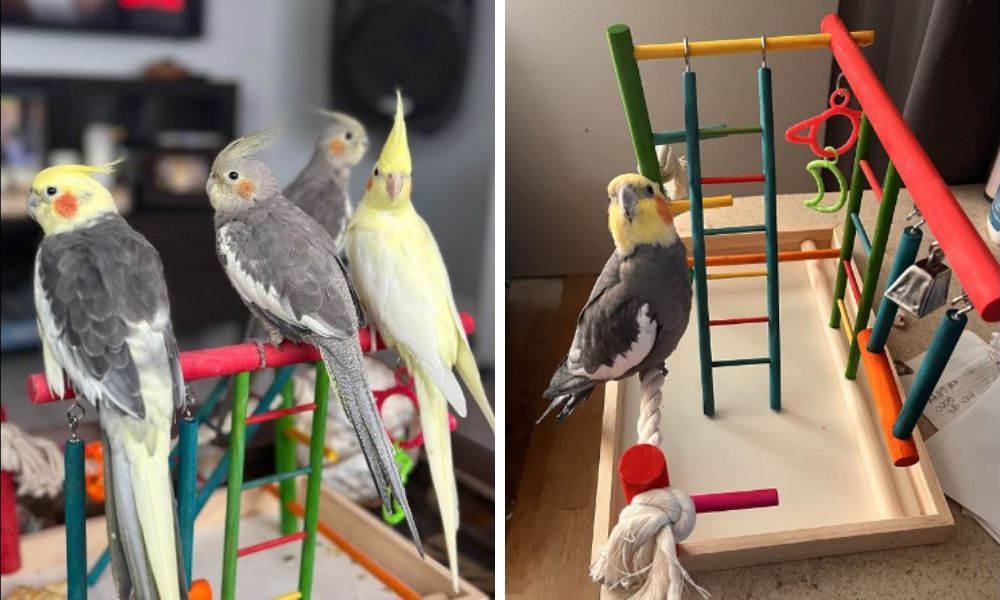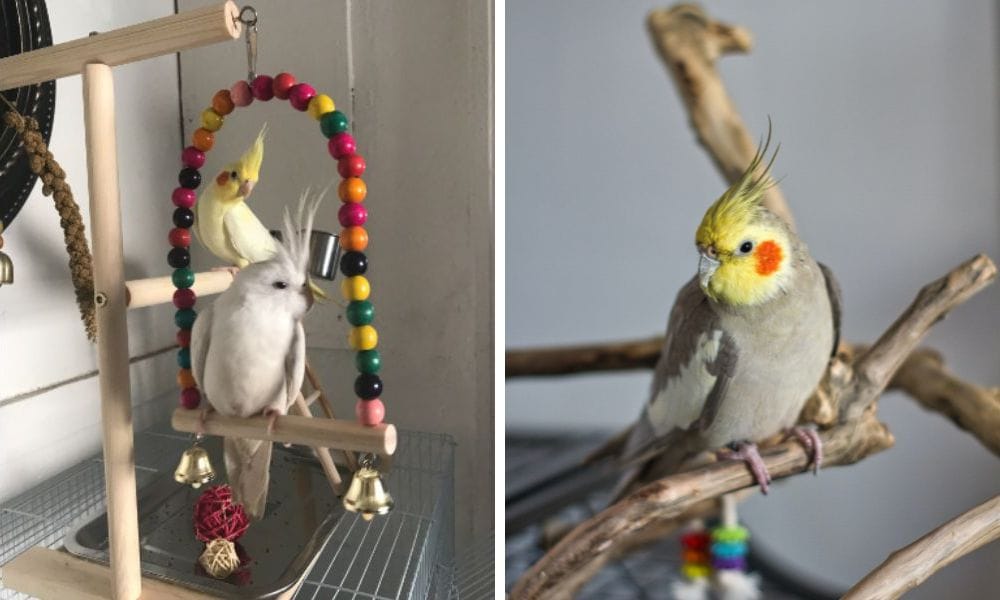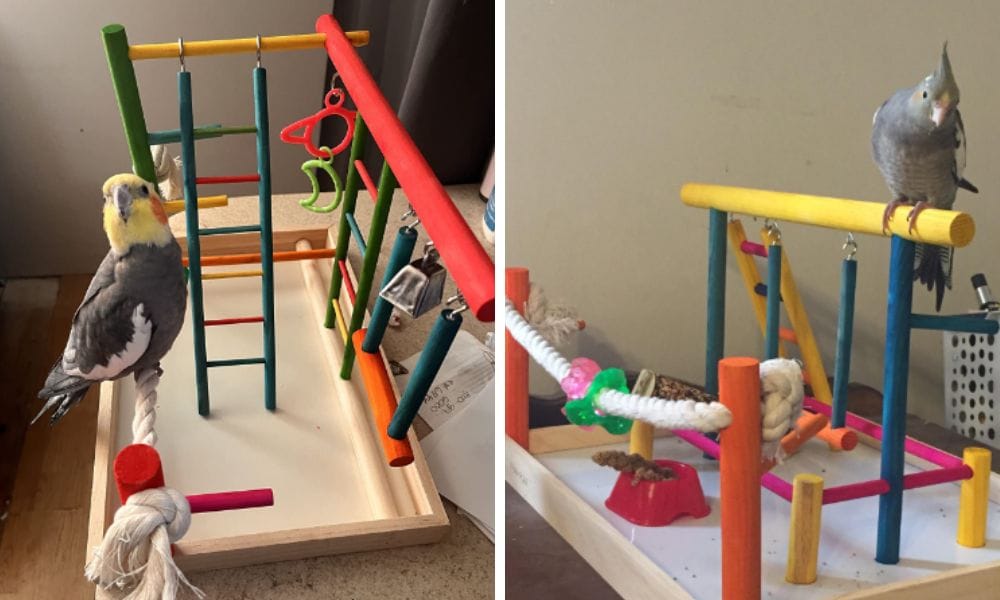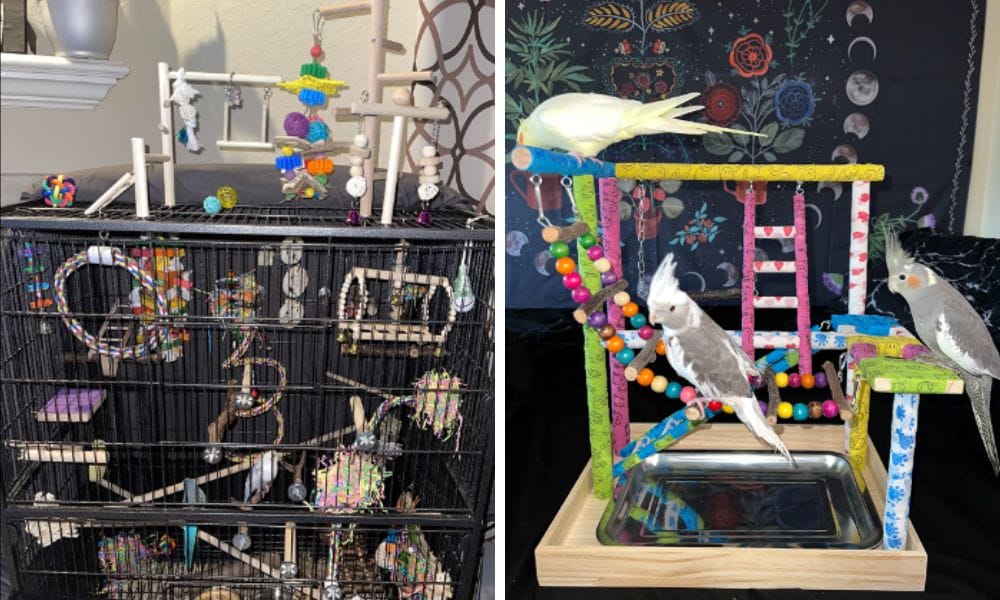Training Your Cockatiel to Enjoy and Utilize Their Cockatiel Playground: Tips and Tricks
Let’s give your Cockatiel the space to explore, learn and have fun! We're here to show you how to properly train your Cockatiel to use their playground as an enrichment activity.

If you’re a bird lover, you know that having a cockatiel for a pet can be both a joy and a challenge. But one of the most rewarding things you can do as a bird owner is to see your cockatiel happily playing and exploring in their own cockatiel playground. Not only is it a great way for them to stay active and engaged, but it also helps keep them mentally stimulated and healthy. In this post, we’ll go over some tips and tricks for training your cockatiel to enjoy and utilize their playground.
Key Takeaways:
- Understand Cockatiel Behavior: Knowing how your cockatiel naturally plays and interacts can significantly enhance the training process.
- Gradual Introduction: Slowly introducing your cockatiel to their new playground will help them feel safe and curious.
- Use of Rewards: Positive reinforcement through treats and verbal praise can motivate your cockatiel to use the playground more frequently.
Cockatiels, with their vibrant personalities and capacity for interaction, make delightful companions. Just like children, these birds need a stimulating environment to live happily and healthily. A cockatiel playground equipped with wood toys and a variety of engaging activities can provide your feathered friend with both physical exercise and mental stimulation. However, getting your cockatiel to initially engage with this new environment can be a challenge. Here are some expert tips and tricks to help your cockatiel not only use but also enjoy their playground.

Understanding Your Cockatiel's Needs
Cockatiels are naturally curious and playful, but they also need time to adapt to new situations and environments. Observing your cockatiel’s behavior closely will give you insights into the best ways to introduce new toys and equipment. For instance, if your cockatiel enjoys chewing, ensure the playground includes plenty of safe wood toys.
The Right Setup
Choosing the right location for the cockatiel playground is crucial. It should be in a place where your bird feels safe yet is part of the family activity. Ensure the playground is stable and made from non-toxic materials to avoid any health hazards. Cockatiels are sensitive to their environments, so the area should be free from loud noises and abrupt disturbances.
Gradual Introduction to the Playground
Start by placing the playground near your cockatiel’s cage. Allow them to observe it from a distance to pique their curiosity. Over several days, gradually move the playground closer to the cage. This slow introduction helps build a sense of familiarity and reduces anxiety.
Using Treats and Rewards
Once your cockatiel starts showing interest in the playground, introduce treats to make the experience more rewarding. Place treats on various parts of the playground to encourage exploration. Every time your cockatiel attempts to play or climbs on the playground, offer them a small treat and verbal praise.

Interactive Play Sessions
Engage directly with your cockatiel by showing them how to use the playground. Demonstrate the fun of swinging on a perch or playing with a toy. Your enthusiasm will likely encourage your pet to mimic your actions. Remember, cockatiels are social creatures and often learn by watching.
Enhancing the Playground with Wood Toys
Cockatiels, like many parrots, have a natural inclination to chew. Integrating wood toys into your cockatiel's playground can significantly enrich their environment and cater to this instinctual behavior. Wood toys not only provide a safe outlet for chewing but also help in maintaining beak health and dexterity. When selecting wood toys, ensure they are made from safe, non-toxic wood such as apple, elm, or birch, which are widely available on platforms like Amazon, ensuring easy access to suitable options.
Adding variety to the types of wood toys can keep your cockatiel engaged and curious. Consider toys that come in different shapes and sizes, such as ladders, perches, and hanging toys, which can be easily attached to the cockatiel gym. These additions not only enhance the physical appeal of the playground but also stimulate your cockatiel's mental and physical activity. Regularly rotating these toys will keep the environment fresh and exciting for your feathered friend, encouraging continuous exploration and play.
Importance of a Cockatiel Chewing Gym
A dedicated chewing gym can be a game-changer in your cockatiel's development and satisfaction. This specialized area within the playground focuses on meeting the natural chewing urges of your cockatiel, preventing them from gnawing on undesirable objects around your home. By centralizing this activity, you also make it easier to monitor and manage your cockatiel's chewing habits, ensuring they are safe and appropriate.
Incorporating a variety of textures and materials in the chewing gym can further enhance its effectiveness. Materials such as untreated leather, ropes, and different types of safe woods can provide your cockatiel with a range of chewing experiences. This not only keeps them entertained but also aids in their cognitive development and stress reduction. Regular updates to the gym's setup can maintain its appeal, making each visit exciting and new for your cockatiel, fostering a healthy, engaging, and enriching playground environment.

Consistency is Key
Consistency in training sessions is vital. Try to dedicate specific times each day for your cockatiel to play on the playground. This routine helps your bird anticipate playtime and reduces reluctance. Each session should last about 10 to 15 minutes to keep your cockatiel engaged without overwhelming them.
Monitoring Playtime
While it’s important for your cockatiel to have fun, it’s equally crucial to ensure they are safe. Regularly inspect the playground for any damaged toys or sharp edges. Additionally, observe your cockatiel’s response to different toys and structures. Some may enjoy perches while others prefer ladders or swings.
Adjustments and Variety
Be prepared to make adjustments to the playground setup based on your cockatiel’s preferences and behaviors. Adding new toys from reputable sources like Amazon can keep the environment exciting and engaging. Rotate the toys and reconfigure the playground periodically to maintain interest.
Encouraging Social Interaction
If possible, introduce another cockatiel or a mirror to simulate social interaction. Cockatiels are flock animals and may enjoy the presence of a companion, whether real or reflected. This can significantly increase their interest in using the playground.
Patience Pays Off
Remember, patience is crucial when training your cockatiel. Some birds may take longer to warm up to the idea of a playground. Continue to use positive reinforcement and avoid any negative reactions if your cockatiel seems hesitant or uninterested at times.

Summary
Training your cockatiel to use and enjoy their playground is a rewarding process that enhances their quality of life. By understanding your cockatiel’s needs, introducing the playground gradually, and using treats and rewards, you can make the playground a favorite spot for your feathered friend. Consistency, safety monitoring, and adjustments based on your cockatiel’s preferences are key to successful training.
FAQ
Q1: How long does it typically take for a cockatiel to start using the playground? A1: The time it takes can vary widely depending on the individual bird. Some might start exploring within a few days, while others might take weeks. Consistent training and positive reinforcement are essential.
Q2: What are the best toys to include in a cockatiel playground? A2: Cockatiels generally enjoy a variety of toys, but especially those they can chew, like safe wood toys, or toys that challenge them like puzzles. Ensure all toys are safe and non-toxic.
Q3: Can older cockatiels still learn to use a new playground? A3: Absolutely! Older cockatiels can learn new tricks and enjoy new play areas just as much as younger birds. The key is a gradual introduction and consistent positive reinforcement.
How do I keep my cockatiel entertained?
Providing a variety of bird toys (chewing toys, puzzles from bird safe wood, safe branches) and activities is the best way to keep your cockatiel entertained. This can include things like perches, swings, ladders, puzzles, bird safe bell, and even homemade toys. Make sure to rotate the items regularly so that they don't get bored with them. Check out our blog about this topic here.

Do cockatiels play with toys?
Yes! Cockatiels love to play with bird toys, and it's a great way for them to stay active and engaged. They love accessories and things like perches, swings, ladders, bells, puzzles, and homemade items like toilet paper rolls or popsicle sticks. Just make sure to rotate through the toys regularly in order to keep them from getting bored.
With the right training, positive reinforcement, and plenty of patience, your bird will be able to explore and enjoy all that their playground has to offer. Not only is it a great way for them to stay active and engaged mentally, but it’s also a fun bonding experience for you and your pet bird.

How to build a cockatiel playground?
Building a bird playground is relatively easy and fun! Start by choosing an area that's safe for your bird, like a playpen or aviary. Then, add in items like perches, swings, ladders, bird safe bell, and variety of toys for necessary exercise. You can even make homemade toys with things like paper towel rolls and popsicle sticks. Mix up the elements occasionally to give your bird something new and exciting to explore.
Playground for Cockatiels and small birds should contain a lot of colors, toys and are typically constructed from solid hardwood. Add laminated floor for easy cleaining. Make sure that the playground area is secure so that your cockatiels, parakeets or small parrots can safely play without any risks of escape. By following these steps, you’ll be able to create a fun and safe playground for your cockatiel to enjoy!
At the end...
In conclusion, training your cockatiel to enjoy and utilize their bird playground is a great way to keep them happy, healthy, and engaged. By following these tips and tricks, you can help your cockatiel develop a love for their playground and all the fun activities it offers. With a little bit of patience and consistency, you and your feathered friend will be enjoying hours of playtime together in no time. Invest in a playground today and watch your cockatiel grow happier and healthier in a fun and enriching world.

